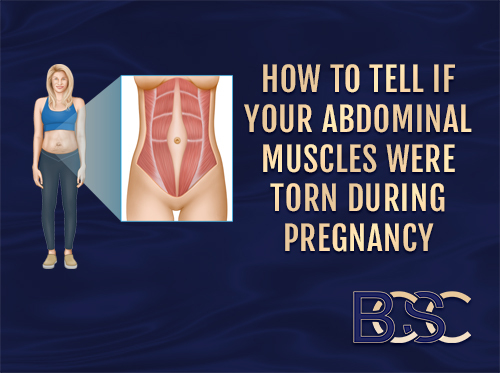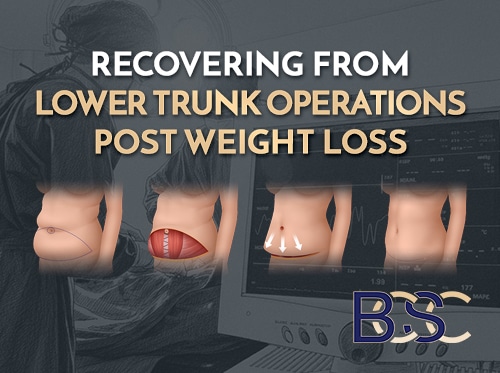Mini vs Full Abdominoplasty: What is the Difference?
When considering a tummy tuck (abdominoplasty), one of the most common decisions is whether to have a mini abdominoplasty or a full abdominoplasty. Both operations aim to remove excess skin from the abdominal area and, when needed, repair stretched or separated abdominal muscles (diastasis recti). The right choice depends on how much loose skin you have, whether your abdominal wall requires muscle repair (Diastasis recti), and the overall change you wish to achieve.
A mini abdominoplasty removes excess, loose skin and fat (adipose tissue) and Diastasis recti on the lower abdomen, while a full abdominoplasty removes skin and repairs loose abdominal muscles over the entire abdominal region.
At Body Contouring Surgery Clinic, our FRACS-qualified surgeons perform both mini and full abdominoplasties. These procedures are often sought after pregnancy, significant weight loss, or age-related changes in the skin and abdominal muscles. Understanding the difference between these two operations will help you make an informed decision during your consultation.
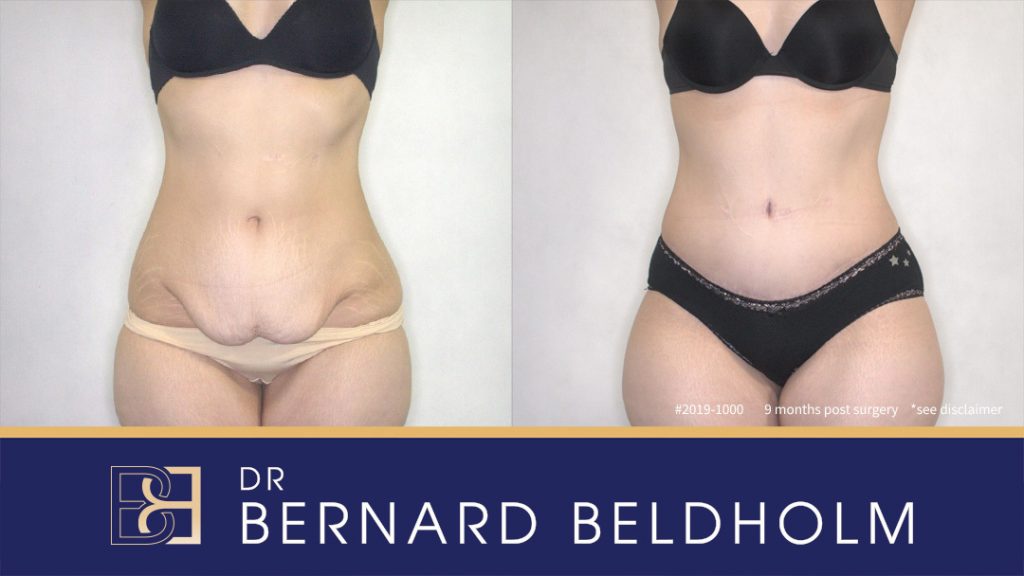
Disclaimer: Operation performed by Dr Bernard Beldholm. Adult content, surgery has risks; individual results vary, seek 2nd opinion. Please see the full disclaimer.
What is a Mini Abdominoplasty?
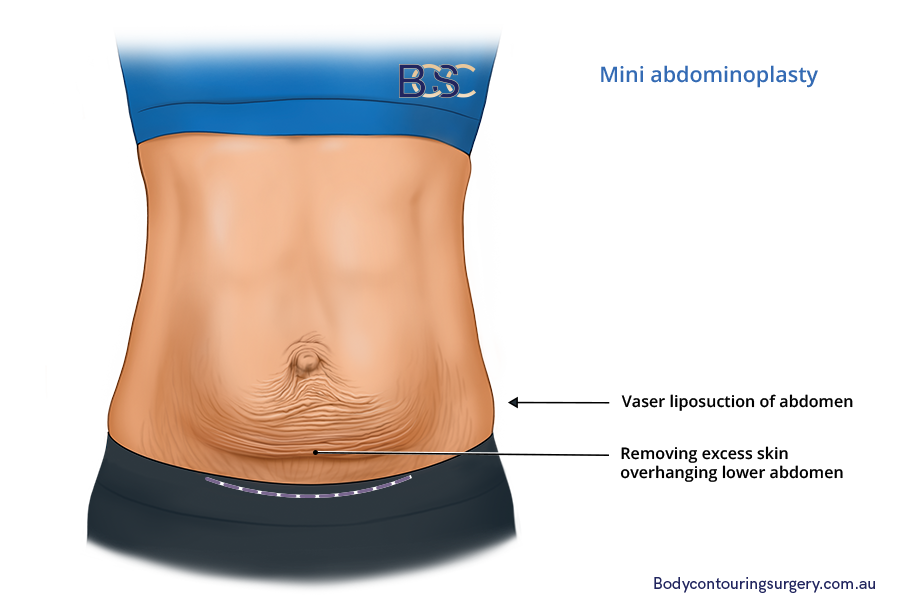
A mini abdominoplasty is less invasive than a full abdominoplasty procedure. It is also referred to as a partial abdominoplasty. The procedure suits patients with minimal or moderate subcutaneous fat and minimal to moderate abdominal wall laxity, primarily in the infra-umbilical region. The procedure focuses on the lower abdomen (below the navel) without repositioning the umbilicus.
- Incision: A shorter incision is made low on the abdomen, often within the bikini line.
- Umbilicus: The umbilicus usually stays in place and does not need to be repositioned.
- Skin removal: Only a smaller portion of skin is removed, typically confined to the lower abdomen.
- Muscle repair: Mild cases of diastasis recti (muscle separation) may be repaired, but the degree of tightening is limited compared to a full procedure.
- Best suited for: Patients with mild to moderate lower abdominal skin excess and no major laxity above the umbilicus.
This procedure may appeal to patients who want a shorter scar, quicker recovery, and improvement limited to the lower abdomen.
What is a Full Abdominoplasty?
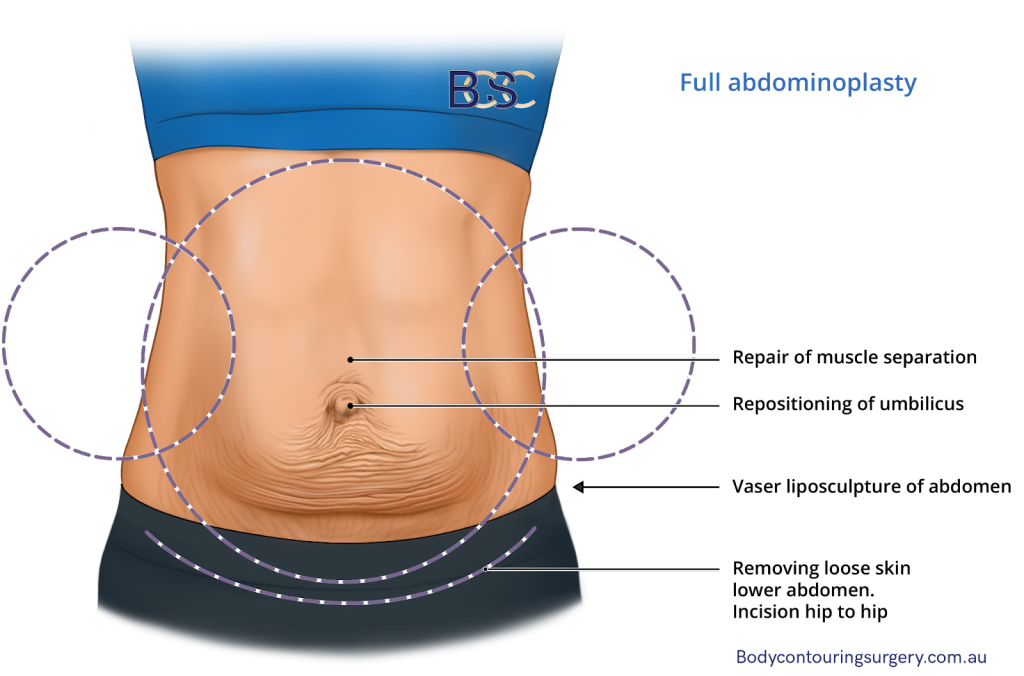
A full abdominoplasty procedure removes excess skin and tightens separated abdominal muscles (diastasis recti) over the entire abdomen. Individuals with excessive fat, skin laxity, and abdominal wall separation (diastasis recti) on the lower and upper abdomen are more suited for this procedure. In addition, it is suitable for women with multiple pregnancies requiring abdominal muscle repair (diastasis recti).
- Incision: A longer incision runs across the lower abdomen, usually from hip to hip, and is positioned low so that it can be concealed beneath clothing.
- Umbilicus: A second incision is made around the umbilicus so it can be repositioned once the skin has been tightened.
- Skin removal: Excess skin is removed from both above and below the umbilicus.
- Muscle repair: Repair of diastasis recti is usually included, which helps strengthen and flatten the abdominal wall.
- Best suited for: Patients with significant skin laxity, stretched or separated abdominal muscles, or changes after major weight loss or multiple pregnancies.
While this procedure achieves a more comprehensive outcome, it also requires a longer incision and recovery period compared to a mini abdominoplasty.
Mini vs Full Abdominoplasty: Comparison
| Feature | Mini Abdominoplasty | Full Abdominoplasty |
|---|---|---|
| Incision | Shorter, low on abdomen (bikini line) | Longer, across lower abdomen (hip-to-hip) |
| Umbilicus | Usually left in place | Repositioned to a natural position |
| Skin removal | Limited, only below the umbilicus | Extensive, above and below the umbilicus |
| Muscle repair (diastasis recti) | Possible in mild cases | Standard part of the procedure |
| Recovery | Generally quicker | Longer, due to more extensive surgery |
| Best suited for | Mild lower abdominal skin excess | Significant skin laxity and abdominal wall changes |
Recovery After Surgery
Recovery will differ depending on the type of abdominoplasty performed.
- Patients undergoing a mini abdominoplasty often return to light activities sooner. However, restrictions on lifting, exercise, and strenuous movement are still necessary in the early weeks.
- Patients who have a full abdominoplasty generally need a longer recovery period because of the larger incision and muscle repair.
For both procedures, aftercare includes wearing compression garments, attending follow-up appointments, and following your surgeon’s instructions. Swelling, bruising, and changes in skin sensation are common during the early recovery phase, and results continue to settle over several months.
Choosing the Right Procedure
Whether a mini or full abdominoplasty is suitable for you depends on your anatomy, health, and goals. Some patients hope for the smaller procedure, but many find that a full abdominoplasty is necessary to address their concerns effectively.
During your consultation at Body Contouring Surgery Clinic, your surgeon will:
- Assess your abdominal skin and muscle tone.
- Explain which type of abdominoplasty best matches your needs.
- Discuss the risks, benefits, and recovery process in detail.
Risks and Considerations
As with any operation, abdominoplasty carries risks. Possible complications include bleeding, infection, delayed wound healing, fluid collections (seroma), changes in skin sensation, scarring, and the potential need for revision surgery. Your surgeon will discuss these risks with you and provide advice specific to your situation.
Conclusion
A mini abdominoplasty is best suited to patients with minor skin excess below the umbilicus and no major muscle separation, while a full abdominoplasty is recommended for those with significant abdominal skin laxity and stretched or separated muscles. The best way to decide which procedure is right for you is to consult a FRACS-qualified surgeon with experience in body contouring.
References
- Michalska, A., Rokita, W., Wolder, D., Pogorzelska, J., & Kaczmarczyk, K. (2018c). Diastasis recti abdominis — a review of treatment methods. Ginekologia Polska, 89(2), 97–101.
- Greminger, R. F. (1987). The Mini-Abdominoplasty. Plastic and Reconstructive Surgery, 79(3), 356–364.
- Nb, S., Wc, H., Mills, S. D., Rajashekara, B., Taylor, Nb, T., Young, H., & Kivuls, J. (2008e). Abdominal Lipectomy: A Prospective Outcomes Study. The Permanente Journal, 12(2), 23–27.
- Israwi, D. E., & Watfa, W. (2023). Rectus Muscle Plication in Mini-abdominoplasty with Umbilicus Preservation. Plastic and Reconstructive Surgery. Global Open, 11(5), e4998.
- Ferraro, G., Rossano, F., Miccoli, A., Contaldo, L., & D’Andrea, F. (2007). Modified Mini-Abdominoplasty: navel transposition and horizontal residual scar. Aesthetic Plastic Surgery, 31(6), 663–665.
- Ramirez, A., Hsieh, T., Cárdenas, J. P., & Lao, W. W. (2020). Abdominoplasty. Annals of Plastic Surgery, 86(3S), S229–S234.
- Singla, N., & Rogier, T. (2022). Abdominoplasty as an acute postoperative pain model: insights from 8 years of clinical trials. Pain, 164(2), 258–270.
- Gutowski, K. (2018). Evidence-Based medicine. Plastic and Reconstructive Surgery, 141(2), 286e–299e.
- Staalesen, T., Elander, A., & Strandell, A. (2012b). A systematic review of outcomes of abdominoplasty. Journal of Plastic Surgery and Hand Surgery, 46(3–4), 139–144.
- Matarasso, A., Matarasso, D. M., & Matarasso, E. J. (2014c). Abdominoplasty. Clinics in Plastic Surgery, 41(4), 655–672.
- Klinger, M., Klinger, F., Giannasi, S., Bandi, V., Vinci, V., Catania, B., Lisa, A., Veronesi, A., Battistini, A., Giaccone, M., Caviggioli, F., & Maione, L. (2021). Aesthetic and Functional Abdominoplasty: Anatomical and Clinical Classification based on a 12-year Retrospective Study. Plastic and Reconstructive Surgery. Global Open, 9(12), e3936.
- De Freitas, R. S., Ascenço, A. S. K., Maluf, I., Nasser, I. J. G., Balbinot, P., Lopes, M. a. C., Forte, A. J., & Sadowski, J. (2013). Acute Abdomen after Abdominoplasty: Differential diagnosis. Aesthetic Plastic Surgery.
